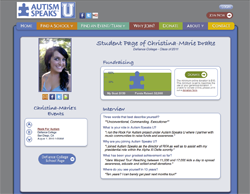 I just read a piece on the Care2.com nonprofit online marketing blog, Frogloop entitled, “The Future of Online Fundraising.” The author, Allyson Kapin writes about a new online fundraising program in which Autism Speaks, through a collaboration with Blackbaud, built Autism Speaks U in an effort to personalize online fundraising for purposes of enlisting those who are intimately familiar and comfortable with using online social networking and other new media online technologies; those especially, who have a willingness to give online to a charitable organization (e.g. those who are high school/college-age a.k.a. the Millenial generation). Nevermind the organization’s controversial ties, let’s focus on the project itself. “[Marc] Sirkin[, Chief Community Officer of Autism Speaks] was inspired to experiment with this fundraising platform because he feels students are the future of philanthropy.” Think of it as the American Cancer Society’s Relay for Life, but the difference is that any one person can hold any event of their own choosing, something I wrote about here on Williteration near the end of March 2010.
I just read a piece on the Care2.com nonprofit online marketing blog, Frogloop entitled, “The Future of Online Fundraising.” The author, Allyson Kapin writes about a new online fundraising program in which Autism Speaks, through a collaboration with Blackbaud, built Autism Speaks U in an effort to personalize online fundraising for purposes of enlisting those who are intimately familiar and comfortable with using online social networking and other new media online technologies; those especially, who have a willingness to give online to a charitable organization (e.g. those who are high school/college-age a.k.a. the Millenial generation). Nevermind the organization’s controversial ties, let’s focus on the project itself. “[Marc] Sirkin[, Chief Community Officer of Autism Speaks] was inspired to experiment with this fundraising platform because he feels students are the future of philanthropy.” Think of it as the American Cancer Society’s Relay for Life, but the difference is that any one person can hold any event of their own choosing, something I wrote about here on Williteration near the end of March 2010.
It appears as if the nonprofit world is incrementally catching on to a tool that enables the supporter to give in the manner that they are most comfortable with. For some it is traditionally organized events that they raise money for or just show up to. For others, including many in my own generation it is organizing an event of our own choosing, with the support of the organizations who will benefit from raising these funds via organizationally-supplied toolkits and media kits (or perhaps more personalized support, provided the event will raise a great amount of money for the organization and require more help to ensure a successful event on the organizer’s end).
Events can be as unique as a person’s creativity will allow. For some it is a bowling event, BBQ and/or house party. For others it is climbing Mt. Kilimanjaro or a bike ride stretching four states. Maybe these events are too labor intensive for some and they would like to set up something as simple as running a lemonade stand (or a virtual one), yet allow family, friends and relatives separated by geographic boundaries to be able to support the event (I am thinking of a elementary-age event here).
Even nonprofit Boards of Trustees, especially those separated by geographic boundaries, can utilize a tool like this to fundraise and collect gifts all around the world, not just in our local communities; although local community gifts are also something to strive for of course. By providing a link on a business card or even using a link shortening service such as Bit.ly or TinyURL can help others remember a link to visit on their iPhones right away as well as laptops or desktops computers at any location when they next get a chance to visit the board member’s personal fundraising page. For many boards, there is a “give, get or get off/get out” expectation. This is one tool among many that they can use to live up to this expectation.
This type of online fundraising tool is not solely relegated to the Millenial generation in its utility. It can be used with a much older demographic provided that their friends are comfortable with the technology as well (e.g. board members).
 I am certainly excited to see how this Autism Speaks project turns out. Perhaps others will seek out branded platforms similar to Autism Speaks through companies such as Blackbaud or Roundpoint or perhaps another route, using exisiting alternatives such as FirstGiving.com. However, having enough trust to enable supporters to raise money for your organization as well as providing the tools to do so is the most crucial step in choosing to test these online fundraising waters. It is a vast untapped resource that could, possibly in the long run, save oranization’s online marketing costs or perhaps serve as an alternative channel to showcase as an option for the fundraiser who wants to help.
I am certainly excited to see how this Autism Speaks project turns out. Perhaps others will seek out branded platforms similar to Autism Speaks through companies such as Blackbaud or Roundpoint or perhaps another route, using exisiting alternatives such as FirstGiving.com. However, having enough trust to enable supporters to raise money for your organization as well as providing the tools to do so is the most crucial step in choosing to test these online fundraising waters. It is a vast untapped resource that could, possibly in the long run, save oranization’s online marketing costs or perhaps serve as an alternative channel to showcase as an option for the fundraiser who wants to help.
This trust that I speak of also means that organizations need to be cognizant that their brand is tested with each organized event. More than likely, no harm will come to the brand. In fact, it may serve to augment the brand and build awareness of the mission the organization seeks to achieve more so than doing damage to it. A great way to defend against misinformation is to supply fact sheets or generalized press releases for the end-fundraiser to utilize in holding their event. Further, a generic timeline on when to release items to friends colleagues and family as well as helpful suggestions for getting others to commit to a fundraising goal as a part of the event or to follow up on pledged donations will help the end-fundraiser turn out a successful event. There is a saying, “Give a man a fish and he eats for a day, teach a man how to fish and you feed him for a lifetime.” The same goes with providing ample resources to those who seek to hold fundraising events to benefit your charitable organization.
Feedback is also very important to the fundraiser. With such successes out there such as Kiva.org, it demonstrates that giving feedback on what each dollar raised does to help that organization and the good it does for that cause is also something organizations venturing into this new arena need to maintain or provide if they are not already doing so. For example, X dollars equals a hammer and X dollars equals some nails to help build a house for an organization that builds housing for families in need, etc.
Finally, venturing out on a limb requires an entrepreneurial spirit and willingness to take a risk. Are you up to the challenge to push the envelope in the world of online fundraising? As Kapin writes, citing Sirkin, “At the end of the day though, Sirkin’s entrepreneurialism shines through. ‘If it fails, it fails. I will think of something else.'” The more that we are willing to accept failure as a possibility, the more willing we are to try something new and learn from it.
If there is a method that is surely going to transform in the next few short years, it is the way we raise money for charitable organizations both online and offline using an integrated tool such as these personalized online fundraising platforms. Imagine the fundraising event possibilities.













Will – thanks for the blog post. I’m thrilled to find your blog and am looking forward to trying to find time to catch up on your older posts and to keep up with your thoughts here.
Thanks Marc. I hope you find what I write about interesting and something worthwhile to contribute to the nonprofit-related dialog. Best of luck to you with your project at Autism Speaks.